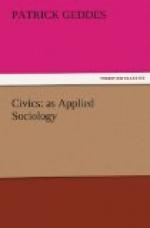The impressiveness of the aspect of Edinburgh to its visitors is thus not [Page: 109] merely pictorial. Be the spectator conscious of this or no, it turns primarily upon the contrast of the mediaeval hill-city with its castle ramparts, its fretted cathedral crown, with park and boulevard, with shops, hotels and railway stations. But the historic panorama is unusually complete. See the hill-fort defended by lake and forest, becoming “castrum puellarum,” becoming a Roman and an Arthurian citadel, a mediaeval stronghold of innumerable sieges, a centre of autocratic and military dictatures, oligarchic governments, at length a museum of the past. So in the city itself. Here the narrow ridge crowded into a single street all the essential organs of a capital, and still presents with the rarest completeness of concentration a conspectus of modern civic life and development; and this alike as regards both spiritual and temporal powers, using these terms in their broadest senses as the respective expressions of the material order and its immaterial counterparts. Thus the royal and noble castles of the Middle Age become with the Renaissance here as everywhere something of palaces, while with the industrial revolution they have become replaced by factories or transformed into breweries. So the guidance of speculative thought, once concentrated in the mediaeval abbey, becomes transferred to the Reformation assembly of divines, to the Renaissance college; and again at the Revolution, is largely taken over by the speculative encyclopaedists, of whom Hume and Smith were but the most eminent. Nor are later developments less obvious. Of the following generation, we have the neo-classic architecture which everywhere dominated Europe after the French Revolution and during the First Empire, while of the next generation’s reaction against all this in the romantic movement, the neo-Gothic monument of Scott is the most characteristic possible representative. Again, just as in the Oxford movement we had the (appropriately regional) renascence of the idealism of the Cavaliers, so in Edinburgh we have naturally the simultaneous renascence of the Puritan ideal, e.g., in the Free Church, whose monument accordingly rises to dominate the city in its turn. The later period of prosperous Liberalism, the heroic enthusiasms of Empire, have each left their mark; and now in the dominant phase of social evolution, that of Finance, the banks, the financial companies, the press are having their turn as monument builders. Our Old Edinburgh is thus the most condensed example, the visible microcosm of the social evolution which is manifest everywhere; so that as a teaching model of sociological development it may renew its educational attractiveness when its improving hygiene has lessened its medical advantages.
Setting down now these phases of historical development in tabular form, we have a diagram such as the following:—




